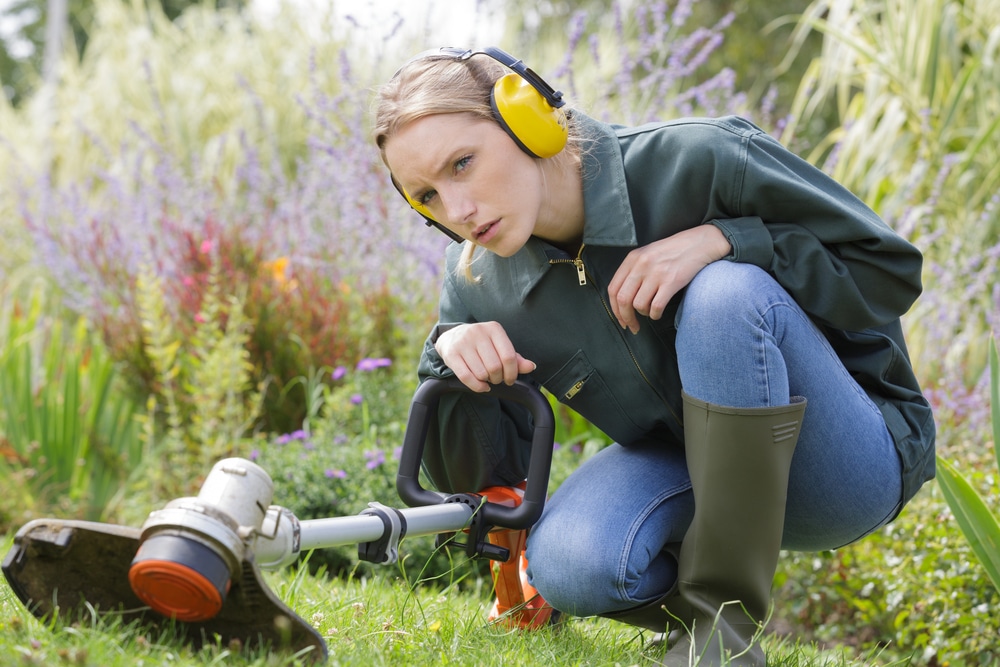Last Updated on
Ah, the joys of home gardening. As any avid gardener knows, one essential tool is a strimmer – but when it starts smoking like an old jalopy on its last legs, you know something isn’t quite right. That’s why I’m here to talk about why is my strimmer smoking and provide some helpful tips for troubleshooting your own garden appliance woes. We’ll take a look at what causes a strimmer to smoke in the first place, how to diagnose and clean or replace parts if necessary, as well as give some preventative maintenance advice so that this problem doesn’t happen again with my strimmer (or yours.). So grab your tools and let’s get started – no need for tears over smoky engines today.
Table of Contents:
- What Causes a Strimmer to Smoke?
- How to Diagnose the Problem
- Cleaning and Replacing Parts
- Troubleshooting Tips
- FAQs in Relation to Why is My Strimmer Smoking
- Conclusion
What Causes a Strimmer to Smoke?
When it comes to strimmers, smoking is a common problem. A strimmer that smokes can be caused by several different issues, some of which are easy to fix and others that require more attention. Here are the most common causes of a strimmer smoking:
Old Spark Plug:
The spark plug is an essential part of your strimmer’s engine and should be checked regularly for wear or damage. If the spark plug is old or worn out, it may cause your strimmer to smoke due to incomplete combustion in the cylinder.
Worn Out Carburettor:
The carburettor mixes air and fuel before they enter the engine’s cylinders. If this mixture isn’t correct, then it can lead to incomplete combustion in the cylinder resulting in smoke coming from your strimmer’s exhaust pipe. Worn out carburettors can also cause poor performance and lack of power when using your machine as well as excessive fuel consumption too.
Clogged Air Filter:
Your air filter helps keep dirt and debris away from entering your engine’s cylinders where they could potentially cause damage if left unchecked. Over time however, these filters become clogged with dust particles which restricts airflow causing a decrease in performance and leading to increased levels of smoke being emitted from your machine while running at full throttle.
Fuel Quality Issues:

Poor quality fuel or stale gasoline can also contribute towards a smoky exhaust on start-up or during operation as well as decreased power output too. This issue is easily solved by ensuring you use fresh high-grade fuels such as unleaded petrol only when filling up your tank – avoid using any low-grade fuels if possible.
Smoking strimmers can be caused by a variety of issues, from worn spark plugs to clogged air filters. To get to the bottom of what is causing your strimmer to smoke, it’s important to take a closer look at the machine and diagnose the problem – let’s explore this further in the next section.
How to Diagnose the Problem
To diagnose the issue, there are several steps you should take.
First, check for fuel leaks. If your strimmer is leaking gas or oil, this could be causing the smoke and needs to be addressed immediately. Make sure all connections are secure and that no hoses have become disconnected or damaged in any way.
Next, inspect the spark plug. A faulty spark plug can cause an engine to misfire which will produce smoke as well as other symptoms such as difficulty starting up or running rough while operating. Check for signs of wear and tear on the spark plug such as cracks or corrosion and replace if necessary with one that matches your model’s specifications exactly.

Thirdly, make sure your air filter is clean and free from debris like dirt or leaves that may have gotten stuck inside it over time due to use outdoors in grassy areas where these things tend to accumulate more easily than indoor spaces would allow for instance. This can block airflow into the engine which will lead to smoking issues so make sure you keep it clean by regularly checking its condition every few months at least.
Finally, examine any belts connected to your strimmer’s motor. Belts can stretch out over time due to regular use, leading them not only becoming less effective but also potentially slipping off their pulleys entirely – both of which will result in an increase in smoking coming from the machine itself. Replace worn-out belts with new ones when needed according to manufacturer instructions found online usually quite easily accessible through search engines like Google etcetera if need be
Once you have identified the source of the smoke, it is time to take steps towards cleaning and replacing any necessary parts to get your strimmer back in working order.
Cleaning and Replacing Parts
It’s not uncommon for a strimmer to smoke, and it can be an alarming sight. But don’t worry – there are some simple steps you can take to get your strimmer back in working order.
The first step is to clean the air filter. This should be done regularly as part of regular maintenance, but if your strimmer has been smoking then this should be done immediately. To do this, remove the air filter from the engine and use compressed air or a brush to remove any dirt or debris that may have built up on it over time. Once cleaned, replace the filter and make sure it fits securely into place before starting up again.

Another possible cause of smoking could be a faulty spark plug. If this is the case then you will need to replace it with a new one – check your manual for instructions on how best to do this safely and correctly. It’s also important that you ensure that all connections are secure when replacing parts so that they don’t come loose during operation which could lead to further problems down the line such as overheating or even fire hazards.
Finally, if none of these solutions work then it might be worth checking out other components such as fuel lines or carburettor settings which could also contribute towards excessive smoke production from your strimmer engine. Refer to your user manual for more information about how best to adjust these settings correctly and safely before attempting any repairs yourself.
By cleaning and replacing parts, you can take the necessary steps to ensure that your strimmer is running optimally. However, if you still experience issues with your strimmer smoking, then the next step would be to troubleshoot further for a more permanent solution.
Troubleshooting Tips
Strimmers are a great tool for tidying up your garden, but they can be tricky to maintain. If you’re having trouble with yours, here are some troubleshooting tips that may help.
Adjusting the Carburettor:
The carburettor is responsible for controlling the air and fuel mixture in your strimmer engine. If it isn’t adjusted correctly, it can cause problems such as poor performance or difficulty starting. To adjust the carburettor on most models, you’ll need to remove the air filter cover and loosen two screws located near the top of the carburettor body. Turn these screws clockwise until they’re snug against their stops before turning them counterclockwise one-and-a-half turns each – this should provide an optimal setting for your strimmer’s engine.
Checking For Fuel Leaks:
A common problem with strimmers is fuel leaking from around its tank cap or other areas of its body. This could be caused by a faulty gasket or seal which needs replacing, so check all seals carefully and replace any damaged ones if necessary. It’s also important to ensure that there aren’t any cracks in either your tank cap or fuel line; if there are then you’ll need to replace both parts before using your strimmer again as this could lead to further damage down the line.
FAQs in Relation to Why is My Strimmer Smoking
Is the smoke coming from the engine or exhaust?
It can be difficult to tell whether the smoke is coming from the engine or exhaust without a visual inspection. However, there are some key indicators that can help you identify where it’s coming from. Generally, if the smoke has a blue tint and smells like burning oil, it is likely coming from the engine. If it has a black tint and smells like burnt rubber or plastic, then it is most likely originating from the exhaust system. Additionally, pay attention to any accompanying sounds as this may provide further clues as to which component of your vehicle is producing the smoke.
Are there any signs of fuel leakage around the carburettor area?
No, there are no signs of fuel leakage around the carburettor area. The carburettor is designed to prevent any fuel from leaking out and it should remain in good condition with regular maintenance. If you suspect that there may be a problem with your carburettor, it is best to take your vehicle to a professional mechanic for inspection and repair if necessary.
Conclusion
So why is my strimmer smoking? Having gone through the steps of diagnosing, cleaning and replacing parts, as well as providing some troubleshooting tips that can prevent your strimmer from smoking in the future, it’s time to wrap up this blog post. Hopefully, you’ve been able to identify what is causing your strimmer to smoke and can now take action on fixing it. Remember that regular maintenance will help keep your strimmer running smoothly and reduce the chances of it smoking again. Good luck.
Paul is the type of person who never met a problem he couldn’t fix. He can always be found tinkering with something in his house, even if it isn’t broken! His tips and tricks are often shared on our site. He’s the one you call when something breaks because he has been known to improvise fixes for everything from leaky faucets to malfunctioning dryers.



